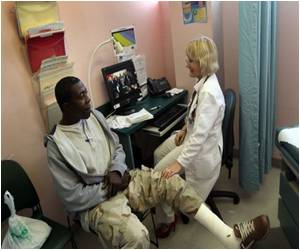
"We suspect this is just the tip of the iceberg," said study author J. Michael McWilliams, associate professor of health care policy. The study appears today in JAMA Internal Medicine.
The researchers said that the methods utilized in the study will provide useful tools for measuring the effectiveness of reform efforts, like those in the Affordable Care Act, aimed at reducing wasteful spending in Medicare and across the health care system.
Pervasive waste Health care spending in America is at an all-time high and continues to rise. Efforts to curb wasteful spending in Medicare and throughout the health care system are crucial to attempts to reduce spending while improving or at least preserving quality of care.
"We were surprised that these wasteful services were so prevalent," said Aaron Schwartz, an MD/PhD student in the HMS Department of Health Care Policy and lead author of the study. "Even just looking at a fraction of wasteful services and using our narrowest definitions of waste, we found that one quarter of Medicare beneficiaries undergo procedures or tests that don't tend to help them get better."
Previous attempts to measure waste in Medicare and other health care systems have relied on comparing overall spending rates between matched patient populations in different geographical areas. The difference between the higher and lower spending areas is attributed to waste. In addition to giving researchers and policy makers a tool to more precisely measure existing waste, the methods used by the researchers can also provide important feedback on reforms designed to curb waste.
Advertisement
Choosing from hundreds of services that have been found to have little clinical value, the researchers identified 26 that would be detectable using the kind of information available in Medicare claims data. They then searched for examples of the 26 services that were likely wasteful among the claims records of 1,360,908 Medicare beneficiaries from 2009.
Advertisement
The estimate of overall waste with the narrower criteria found that 25 percent of beneficiaries received at least one of the wasteful services, resulting in a total of $1.9 billion in Medicare spending. The broader version found that 42 percent of beneficiaries were affected at a cost of $8.4 billion in potentially wasteful spending.
"One of the things we learned from this study is that measuring waste is hard," Schwartz said. "How much waste you find varies greatly depending on how you define it. Removed from the clinical details of a particular patient, it is hard to know whether a given procedure might be useful or not."
Measuring reform "Because the value of a service depends on the patient, it is challenging to devise payment and coverage policies that limit wasteful care but not valuable care. Some tests and treatments that are wasteful across the board are easy targets—we can stop paying for them. But for most services, incentives that allow providers greater discretion at the point of care may be needed to cut significant amounts of waste while minimizing unintended consequences," said McWilliams, who is also a practicing general internist at Brigham and Women's Hospital
Instead of limiting care through coverage design or payment restrictions, the researchers see potential in global payment models that replace fee-for-service reimbursement with incentives to keep spending within a global budget and improve quality of care. These models could allow physicians and provider organizations to use more detailed clinical information to identify many more low-value services while encouraging their elimination. There are numerous low-value services—identified for example by specialty societies through campaigns like Choosing Wisely—that are difficult to measure well with claims data but could nevertheless be targeted by such broader payment reforms.
"That's the theory behind reform experiments being implemented under the Affordable Care Act and through private insurers," Schwartz said. "It's exciting that we now have a tool to measure how well global budgets and similar reforms perform at the specific task of cutting wasteful spending."
Source-Eurekalert










